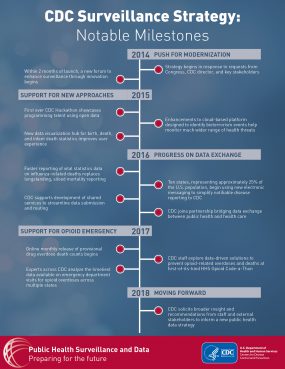Project — Improving Public Health Surveillance and Data at CDC

Public health is never static—and neither is public health data. Just in the past two decades, we’ve witnessed public health’s evolution from monitoring infectious diseases to tracking the occurrence of many noninfectious conditions, such as injuries, birth defects, chronic conditions, mental illness, drug use, and environmental and occupational exposures to health risks.
With this widened surveillance lens, CDC is updating the surveillance strategy to keep up with the rapidly changing landscape of data and need for IT modernization. Beginning in 2018, the agency is extending the work to encompass public health data more broadly, and creating a more connected and secure data and IT infrastructure.
The new strategy has several components:
- Growing public health’s data science, informatics, and IT savvy workforce
- Expanding core data, informatics, and IT capacity
- Advancing interoperable systems and tools
- Strengthening and expanding collaboration with and support for partners
- Coordinating data and IT investments and governance

Chesley Richards, MD, MPH, FACP
CDC Deputy Director,
Public Health Scientific Services
How can CDC and public health organizations stay current and remain leaders in a changing landscape of data and Health Information Technology?
Listen to the podcast below.
An invalid iFrame was removed due to an non-compliant URL. The URL must be secure (https) and exist on a CDC.gov domain.
Keywords: Health Information Technology, prevention, population health, workforce
Related Links
- Pulse Check Our Progress
These metrics represent progress from 2014-2018 accomplished under the Surveillance Strategy - Public Health Surveillance at CDC
This inventory of CDC surveillance systems and investments was the first to characterize surveillance at CDC using administrative data.
Videos:
- Conversations on Public Health Surveillance with Hillard Weinstock, MD, MPH
- Conversations on Public Health Surveillance
Featured interviews with experts from around CDC which showcase the work being done to improve surveillance at the local, state and federal levels. - Public Health Surveillance – a brief overview
Podcast:
Fact Sheet:
Graphics:
- Modernizing Notifiable Diseases—How Counting Cases Prompts Action
- Bridging Public Health and Health Care – Better Exchange, Better Data
- Connecting Real Time Data – When Symptoms Send a Signal
- Revolutionizing Public Health Data Systems – How Sharing Advances Surveillance
- Moving Lab Reporting at the Speed of Light
- Modernizing Death Reporting
- When Informatics Promotes Innovation
